Brainless animals don’t need it in the first place to live their life. It may sound impossible, but it is true nevertheless.
Many animals survive without some of the vital organs humans have, including the heart and brain.
While we need the brain as a “central processing unit,” these creatures function fine without it.
Animals without brains include sea urchins, sea cucumbers, starfish, corals, jellyfish, clams, etc.
They have very simple or rudimentary nervous systems that may not be considered “brains” in the same way that we typically think of them.
Let’s discover more animals with no brains and how they manage to perform and control their activities.
These Animals Without Brains Function Just Fine
1. Sea Urchins (Echinoidea)
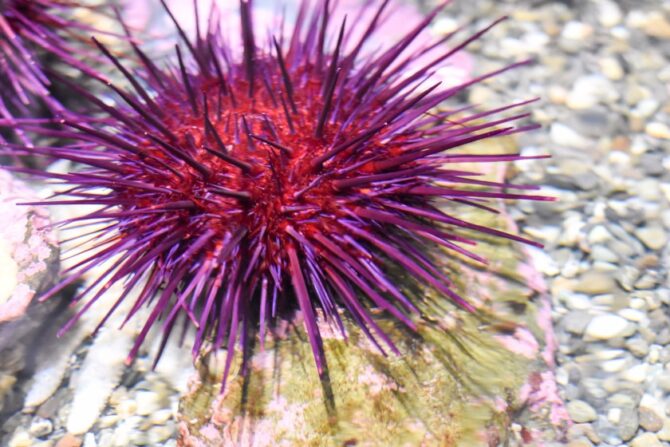
The sea urchin falls under class Echinoidea, with around 950 species.
This creature can be found in every ocean, living on the seabed.
It is described as spiky, which is not good news for anyone who accidentally steps on it. It also has many legs but moves slowly.
The sea urchin has neither a brain nor a heart, as it doesn’t require both organs to survive.
It relies on a water vascular system in place of a circulatory system and a nerve ring around its mouth.
Some sea urchins are poisonous, but they rarely kill.
2. Sea Cucumber (Holothuroidea)

The sea cucumber is named so due to its similarities with an actual cucumber.
It belongs to the class Holothuroidea, known for its leathery skin and long body.
Humans eat sea cucumbers and keep them in aquariums, but they can be dangerous too.
These animals release a toxin known as holothurin, which can make someone blind.1 Perhaps it’s good they don’t have the brains to consciously attack people.
In the place of a brain, the sea cucumber has neural tissue that signals the mouth and tentacles.
Sea cucumbers also inhabit every ocean, with around 1,717 species.
3. Jellyfish (Medusozoa)
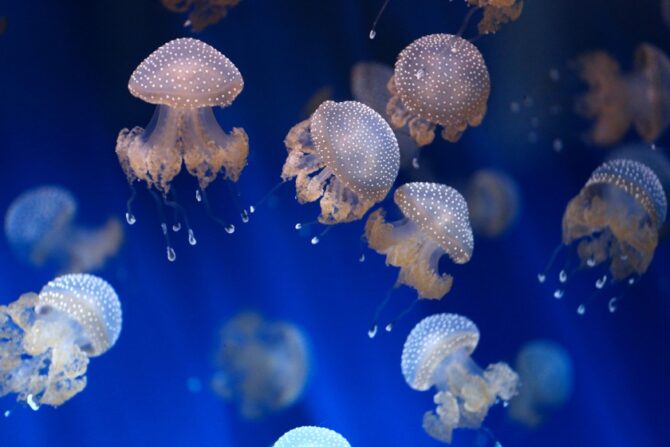
The jellyfish is the common term for creatures in the subphylum Medusozoa, classified under the phylum Cnidaria.
Unlike the aforementioned creatures, the jellyfish doesn’t remain hooked on the seabed.
It swims freely in the ocean. The jellyfish is a popular marine animal notorious for the sting it gives.2
In the place of brains, jellyfish have neurons that do the job well. They have a nerve net that is distributed throughout their body, which allows them to sense their environment and respond to stimuli.
They also survive without a heart and take oxygen through the skin.
4. Corals (Anthozoa)

Sometimes regarded as plants, corals are animals. They fall under the class Anthozoa in the phylum Cnidaria.
You’d often find them in tropical waters. Corals are also known to form skeletons with the calcium carbonate they secrete. There are around 6,000 species.
What functions as a brain for corals is the nerve net, a nervous system that goes from the mouth to the tentacles.
These animals are vital to the aquatic ecosystem as they create homes for many fish.
5. Clams (Mollusca)

Clams belong to the Mollusca phylum, the second-largest invertebrate phylum in the world.
They are described as bivalves because of their shells which can be opened and closed.
Close relatives include oysters, mussels, and scallops.
Clams have beating hearts, kidneys, and a stomach. However, they have no brains.
There’s a nervous system in place of the brain that enables clams to feel or think. They live in both saltwater and freshwater.
6. Sea Lilies (Crinoidea)

Sea lilies are also called crinoids, all of which belong to the Crinoidea class.
There are two forms of sea lilies. One stays at the bottom of the sea while the other moves freely.
The latter is termed feather stars or comatulids. Due to both forms, you can find the sea lily in either the depth or shallow waters.
Sea lilies are similar to plants and commonly mistaken for one, but they are animals.
In place of a brain, it survives using a nervous system. Unsurprisingly, it is related to both sea cucumbers and sea urchins.
7. Sea Sponge (Porifera)
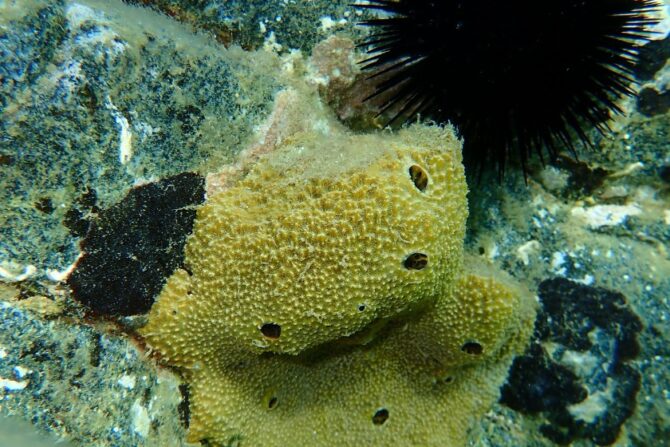
The sea sponge is an odd creature in many ways. Besides its lack of brains, it also has no internal organs.
Sea sponge species belong to the phylum Porifera and are known to have many cells.
Fossil records date them to around 200 million years ago. Their long existence is due to their long lifespan. These animals can live up to 200 years.
How do these animals survive with no brains or internal organs?
They do this by eating tiny organisms around them. The majority of the 5,000 species live in saltwater, with only a minority staying in freshwater habitats.
8. Oysters (Ostreoidea)

Oysters are spread across different groups in the subclass Pteriomorphia.
The most common is the Ostreoidea superfamily which comprises the majority of the population. They are usually found in brackish and salt water.
This creature has a heart and internal organs, but in the place of brains, it has a nervous system.
Like the sea sponge, the oyster has been around for long, dating to 15 million years back.
9. Sea Squirts (Ascidiacea)
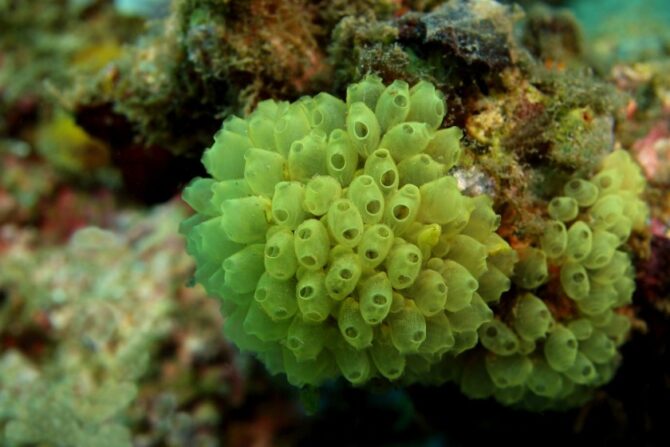
The sea squirt’s official name is Ascidian. It is called a “sea squirt” because it squirts water when away from an aquatic habitat.
It is also known as the truncates. It belongs to the subphylum Tunicata and falls under the group of invertebrate filter feeders.
Sea squirts have a nervous system in place of the brain specially designed for touch. They are often found tied to ships.
10. Sea Anemones (Actiniaria)
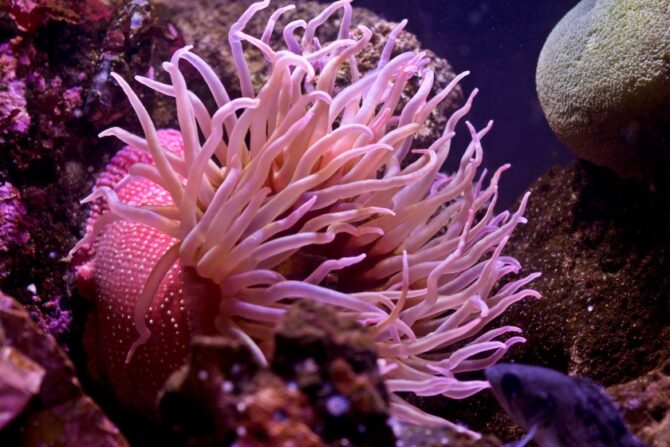
The sea anemone is a member of the order Actiniaria, described as both a predator and an invertebrate.
The common name is derived from a beautiful plant named Anemone. Its beauty also earned it the nickname “flowers of the sea.”
Many of their relatives appear on this list, like the jellyfish and the coral.
The nervous system of this creature is simple but sufficient to play the role of a brain.
It is also a nerve net like its relatives, helping it pick up stimuli. As a predator, it relies on the nervous system to capture prey.
11. Starfish (Asteroidea)
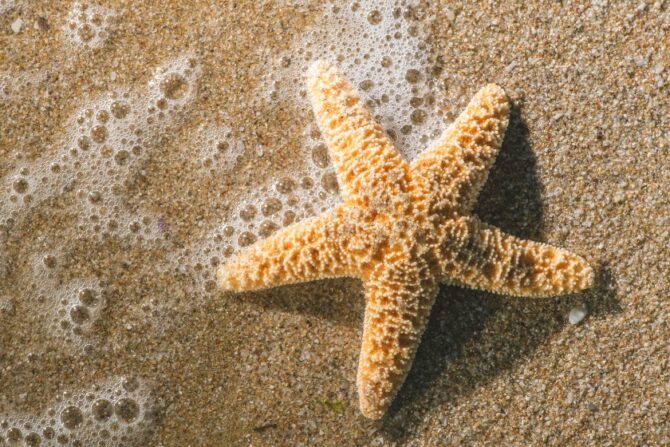
The starfish is also known as the sea star or the asteroid, an echinoderm in the class Asteroidea.
Starfish live on sea beds at the bottom of different kinds of oceans, both warm and cold. There are over 1,900 species.
Starfish have no heart, blood, or brain. They live with a water vascular system and a nervous system.
These aren’t their standout features, however. Starfish can grow back an arm if it gets cut.
12. Portuguese man o’ War (Physalia physalis)
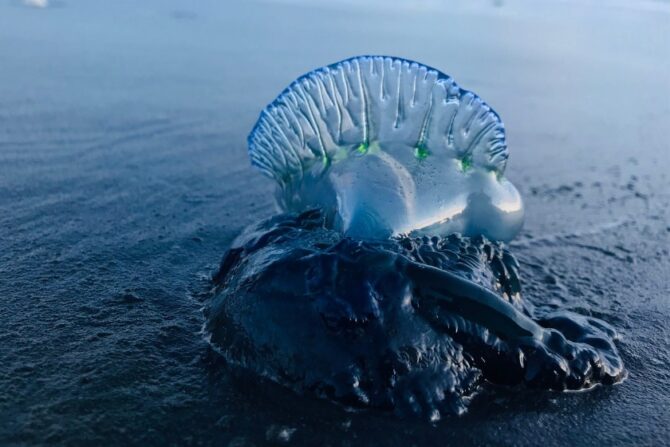
The Portuguese man o’ war is a species that lives both in the Atlantic and Indian oceans.
A variant is also considered to stay in the Pacific Ocean known as the Pacific man o’ war or the blue bottle.
It is the only species in the genus Physalia. This creature looks like a jellyfish but is a different animal altogether.
The Portuguese man o’ war is viewed as an animal, but in reality, it is an interdependent colony of polyps.
The man o’ war has no brains or hearts. It even has no skeletons or gills.
This strange animal survives with the float and appendages on its body.
Its most common physical feature is the sting, capable of causing harm.3
13. Earthworm (Annelida)

Earthworms are popular invertebrates that belong to the phylum Annelida. They live on land and can be found worldwide except in Antarctica.
It often thrives in an ideal environment with soil, water, and temperature.
Following the pattern of other creatures on this list, earthworms have no brains or hearts.
Instead, they have a simple nervous system known as the cerebral ganglion, which functions as a type of brain.4
Conclusion
Major land animals like mammals, reptiles, and amphibians need brains to survive and would be dead without one.
Many aquatic animals don’t have this requirement. What they have are nervous systems that help them sense stimuli in their environment.
References & Notes
- Holothurin, toxin. Britannica.
- Jellyfish stings – Symptoms and causes. Mayo Clinic.
- What is a Portuguese Man o’ War? National Ocean Service.
- Inside of an earthworm. Science Learning Hub.






